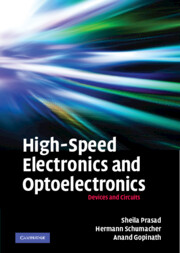Preface
Published online by Cambridge University Press: 05 August 2012
Summary
Starting from the development of transistor technology to laser technology, the field of solid state devices and their circuit applications has advanced rapidly. The silicon bipolar junction transistor was first applied to low frequency circuits. The subsequent advances in materials science made it possible to fabricate compound semiconductor transistors capable of operating at microwave frequencies and high speeds. This presented the capability of applications in both analogue and digital circuits. At the same time, the wide choice of high performance semiconductor materials also enabled the development of optoelectronic devices such as lasers and light-emitting diodes. The communications industry continues to grow and diversify, thus necessitating the design of circuits which will satisfy the requirements of mobile telephones which are becoming more and more sophisticated in their performance. Circuit design has applications in other areas such as optical communications.
This book focusses on high-speed electronics and optoelectronics where the devices operate at frequencies ≥1 GHz. It is presented in two parts with devices being discussed in the first part and the circuit applications in the second part. In Part One, semiconductor devices fabricated in a variety of material systems – Si, III–V compound semiconductors and SiGe – are presented. We discuss the concepts and the fundamental principles of operation. We do not attempt to present the latest results as they will already be obsolete by the time the book is published. It is assumed that the reader has had a course in fundamental solid state physics.
Information
- Type
- Chapter
- Information
- High-Speed Electronics and OptoelectronicsDevices and Circuits, pp. vii - viiiPublisher: Cambridge University PressPrint publication year: 2009
